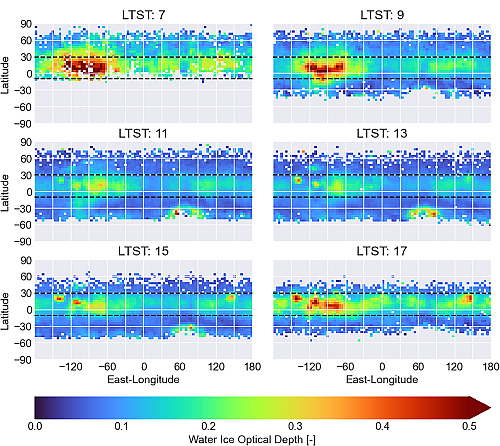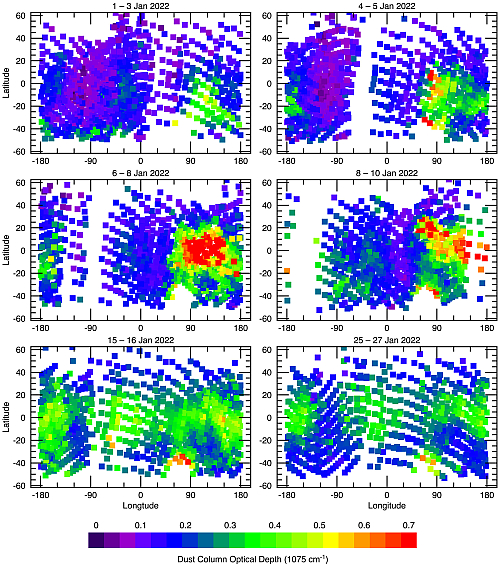Dust and clouds in the Martian atmosphere, as seen by UAE’s Al-Amal orbiter
Two new science papers have just been released detailing results from the Al-Amal (Hope) Mars orbiter that was designed and built by American universities for the United Arab Emirates (UAE).
Both papers used data obtained from the orbiter’s infrared spectrometer, dubbed the Emirates Mars Infrared Spectrometer (EMIRS).

Figure 1 from paper. Click for full image.
First, the instrument tracked the daily changes in the planet’s cloud cover.
A prominent region of clouds that is commonly observed near the equator during Mars’ cold season—known as the aphelion cloud belt—was observed to reach a minimum near midday, with more clouds typically observed in both the morning and afternoon. Distinct differences were found in clouds observed near volcanoes, which tended to reach a minimum before local noon and increase throughout the afternoon.
The figure to the right shows this. In the morning and afternoon (LTST’s 7 and 17), there is a high concentration of clouds in the equatorial region above the Tharsis Bulge where the highest Martian volcanoes are located. During the middle of the day (LTSTs 11 and 13) this cloud cover largely dissipates, with a corresponding increase in cloud cover in Hellas Basin, in the southern hemisphere.
The second paper took a more general look at the data, including the change in temperature depending on elevation as well as dust and water content during the Martian northern spring and summer. From the abstract:

Figure 1 from paper. Click for full image.
The results show that Mars was relatively cool, relatively cloudy, but with little dust. This was expected given the season on Mars that was observed. More surprising was the observation of a dust storm that occurred earlier in the Martian year than usual.
The graph to the right shows that storm’s development and dissipation during January 2022. It began in the low southern latitudes and moved north to mostly hang in the northern equatorial regions north of Hellas Basin. Al-Amal released a Mars global image of this storm in February, which because it was above Perseverance in Jezero crater had interfered with the scheduling of Ingenuity’s 20th flight.
Dust storm season for Mars is usually during the winter, so the detection of a regional storm in the northern summer was unexpected.
On Christmas Eve 1968 three Americans became the first humans to visit another world. What they did to celebrate was unexpected and profound, and will be remembered throughout all human history. Genesis: the Story of Apollo 8, Robert Zimmerman's classic history of humanity's first journey to another world, tells that story, and it is now available as both an ebook and an audiobook, both with a foreword by Valerie Anders and a new introduction by Robert Zimmerman.
The print edition can be purchased at Amazon or from any other book seller. If you want an autographed copy the price is $60 for the hardback and $45 for the paperback, plus $8 shipping for each. Go here for purchasing details. The ebook is available everywhere for $5.99 (before discount) at amazon, or direct from my ebook publisher, ebookit. If you buy it from ebookit you don't support the big tech companies and the author gets a bigger cut much sooner.
The audiobook is also available at all these vendors, and is also free with a 30-day trial membership to Audible.
"Not simply about one mission, [Genesis] is also the history of America's quest for the moon... Zimmerman has done a masterful job of tying disparate events together into a solid account of one of America's greatest human triumphs."--San Antonio Express-News
Two new science papers have just been released detailing results from the Al-Amal (Hope) Mars orbiter that was designed and built by American universities for the United Arab Emirates (UAE).
Both papers used data obtained from the orbiter’s infrared spectrometer, dubbed the Emirates Mars Infrared Spectrometer (EMIRS).

Figure 1 from paper. Click for full image.
First, the instrument tracked the daily changes in the planet’s cloud cover.
A prominent region of clouds that is commonly observed near the equator during Mars’ cold season—known as the aphelion cloud belt—was observed to reach a minimum near midday, with more clouds typically observed in both the morning and afternoon. Distinct differences were found in clouds observed near volcanoes, which tended to reach a minimum before local noon and increase throughout the afternoon.
The figure to the right shows this. In the morning and afternoon (LTST’s 7 and 17), there is a high concentration of clouds in the equatorial region above the Tharsis Bulge where the highest Martian volcanoes are located. During the middle of the day (LTSTs 11 and 13) this cloud cover largely dissipates, with a corresponding increase in cloud cover in Hellas Basin, in the southern hemisphere.
The second paper took a more general look at the data, including the change in temperature depending on elevation as well as dust and water content during the Martian northern spring and summer. From the abstract:

Figure 1 from paper. Click for full image.
The results show that Mars was relatively cool, relatively cloudy, but with little dust. This was expected given the season on Mars that was observed. More surprising was the observation of a dust storm that occurred earlier in the Martian year than usual.
The graph to the right shows that storm’s development and dissipation during January 2022. It began in the low southern latitudes and moved north to mostly hang in the northern equatorial regions north of Hellas Basin. Al-Amal released a Mars global image of this storm in February, which because it was above Perseverance in Jezero crater had interfered with the scheduling of Ingenuity’s 20th flight.
Dust storm season for Mars is usually during the winter, so the detection of a regional storm in the northern summer was unexpected.
On Christmas Eve 1968 three Americans became the first humans to visit another world. What they did to celebrate was unexpected and profound, and will be remembered throughout all human history. Genesis: the Story of Apollo 8, Robert Zimmerman's classic history of humanity's first journey to another world, tells that story, and it is now available as both an ebook and an audiobook, both with a foreword by Valerie Anders and a new introduction by Robert Zimmerman.
The print edition can be purchased at Amazon or from any other book seller. If you want an autographed copy the price is $60 for the hardback and $45 for the paperback, plus $8 shipping for each. Go here for purchasing details. The ebook is available everywhere for $5.99 (before discount) at amazon, or direct from my ebook publisher, ebookit. If you buy it from ebookit you don't support the big tech companies and the author gets a bigger cut much sooner.
The audiobook is also available at all these vendors, and is also free with a 30-day trial membership to Audible.
"Not simply about one mission, [Genesis] is also the history of America's quest for the moon... Zimmerman has done a masterful job of tying disparate events together into a solid account of one of America's greatest human triumphs."--San Antonio Express-News

